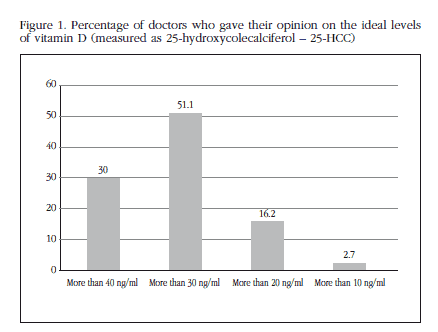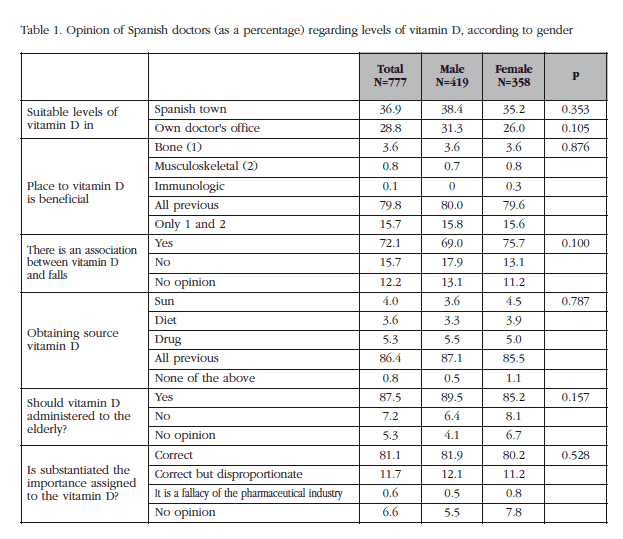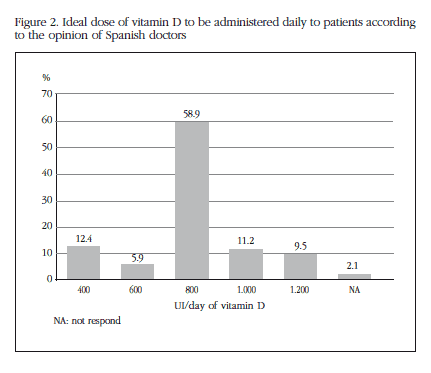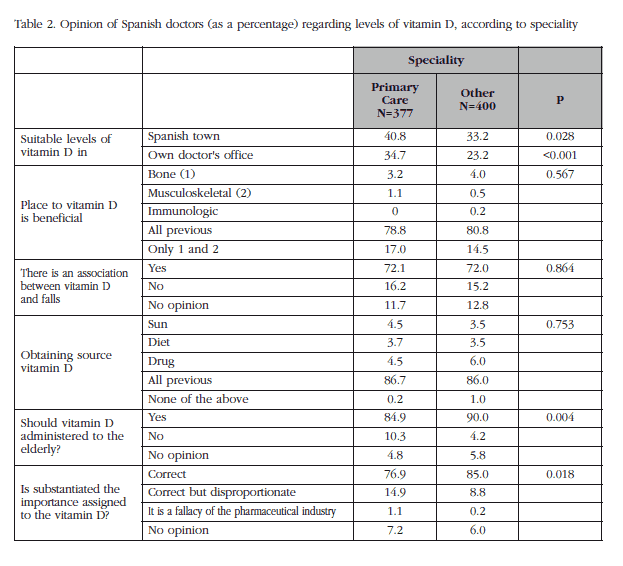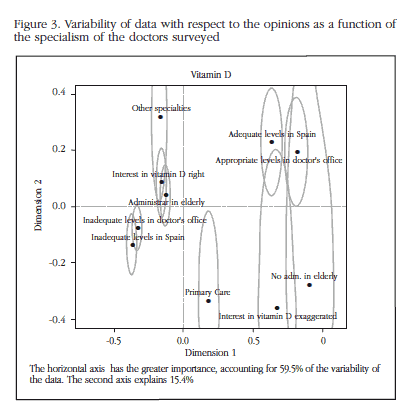My SciELO
Services on Demand
Journal
Article
Indicators
-
 Cited by SciELO
Cited by SciELO -
 Access statistics
Access statistics
Related links
-
 Cited by Google
Cited by Google -
 Similars in
SciELO
Similars in
SciELO -
 Similars in Google
Similars in Google
Share
Revista de Osteoporosis y Metabolismo Mineral
On-line version ISSN 2173-2345Print version ISSN 1889-836X
Rev Osteoporos Metab Miner vol.6 suppl.1 Madrid Mar. 2014
https://dx.doi.org/10.4321/S1889-836X2014000500005
What perception do Spanish doctors have of vitamin D?
¿Cuál es la percepción que tienen sobre la vitamina D los médicos españoles?
Sosa Henríquez M.1,2, Saavedra Santana P.3, Díaz Curiel M.4
1 Universidad de Las Palmas de Gran Canaria - Grupo de Investigación en Osteoporosis y Metabolismo Mineral
2 Servicio Canario de la Salud - Hospital Universitario Insular - Unidad Metabólica Ósea - Las Palmas de Gran Canaria
3 Universidad de Las Palmas de Gran Canaria - Departamento de Matemáticas - Las Palmas de Gran Canaria
4 Fundación Jiménez Díaz - Hospital Nuestra Señora de la Concepción - Unidad Metabólica - Madrid
Introduction
The last few years have seen a notable advance in the understanding of practically all the fields of study related vitamin D, which has resulted in it being considered to be a vitamin which is recognised as a steroid hormone [1-4].
Although vitamin D is classically related with bone mineral metabolism, its effects on practically the whole organism, the so-called "extra-bone" effects of vitamin D, are becoming increasingly better understood [2,3,5-8], and which have been reviewed in another article in this Monograph [9].
In the literature consulted we found scant reference to the opinions of Spanish doctors regarding different aspects of vitamin D in the Spanish population in general or in their patients, their views on desirable levels of vitamin D, and lastly, the dose they would recommend be administered. In this study we would like to make a first approximation of these data, which will allow us to understand what knowledge Spanish doctors have of vitamin D.
Material and method
To carry out this study we obtained data on the whole population of doctors specialising in primary care, rheumatology, traumatology, internal medicine, rehabilitation and endocrinology in Spain, classified according to their respective autonomous communities. Subsequently they were grouped as primary care specialists and other specialists (the rest).
The sample size in each study group (primary care, and other specialists), was determined in order to estimate each proportion with an error quotient of 5%. To achieve this it was necessary that 381 questionnaires be completed in each of the groups.
The participants were invited to access a web page which contained a questionnaire designed for the study and where they had to enter the data directly. Each doctor could on access only one questionnaire by means of a code which had been provided earlier. The questionnaire was completed in approximately 2 minutes and the data exported to an Excel spreadsheet, and then imported into the SPSS® programme, where the statistical calculations were performed.
Statistical analysis. In all the groups considered, the variables were summarised as percentages, which were compared using the χ2 test. A hypothesis test was considered statistically significant when the corresponding p value was less than 0.05. Those variables which showed a significant association with a specialism (primary care/other) were put through a multidimensional correspondence analysis. From the χ2 distance between the categories in the Burt table a group of points was generated in a space with the dimension p -1. The first two principal components were then extracted and the variability percentages explained by each of the components were evaluated. The data were analysed using the statistical software package R.
In addition to classifying the participants as a function of their specialisms in two groups (primary care and other specialisms), a second stage addressed gender, so enabling the opinions of the men to be compared with those of the women.
Results
1. Description of the participants in the study
A total of 777 doctors across Spain responded to the survey, 419 male (53.9%) and 358 (46.1%) female. The overall mean age was 46.6±8.9 years, with the males being older than the females (49.1±8.7 years vs 43.7±8.3 years, p<0.001).
Approximately half of the doctors, 377 (48.5%), worked in primary care. Of the remaining 400 (51.1%), who were hospital specialists, the most common specialisms were rheumatology (15.3%), traumatology (11.3%) and rehabilitation (9.5%).
Doctors from all 17 of the autonomous communities participated. Andalucia, with 98 doctors (12.6%) was the autonomous community with the highest rate of participation, followed by Catalonia with 82 doctors (10.6%). Cantabria, with 19 doctors, was the autonomous community which had the lowest number of responses.
Figure 1 shows the results obtained when the doctors were asked what they considered to be the ideal levels of vitamin D, measured by its reserve metabolite, 25-hydroxyvitamin D (25-HCC). As may be observed, more than 80% of those surveyed (81.1%) were of the opinion that patients needed to have a value of 25-HCC higher than 30 ng/ml. While only 2.7% thought that this value should be greater than 10 ng/ml.
2. Results expressed as a function of the gender of the participants
In Table 1 are recorded the opinions of Spanish doctors regarding different aspects of vitamin D, expressed globally on the one hand, and as a function of gender on the other. Only 36% thought that the Spanish population in general had sufficient levels of vitamin D, and those who thought that patients attending their clinics had sufficient levels of vitamin D amounted to less than 30% (28.8%). There were no statistically significant differences in the these opinions as a function of the doctors' gender.
When asked where they thought vitamin D exerted it beneficial effects, almost 80% (79.8%) thought that this effect occurred both in the bone and in the musculo-skeletal and immune systems. Furthermore, 72.1% of the doctors surveyed thought that there was a relationship between levels of vitamin D and falls. Again, no statistically significant differences were observed in these opinions as a function of the gender of the doctors. With regard to the way vitamin D was obtained, the majority of Spanish doctors (86.5%), thought that all available means should be used, which included exposure to sun, dietary intake or by means of drugs. So, in the specific case of older people, a great proportion of the doctors (87.5%) were in favour of the administration of vitamin D supplements to this group.
With regard to whether the current interest in vitamin D is correct, disproportionate, or is a fallacy of the pharmaceutical industry, 81.1% of those surveyed though that the interest was correct, and only 0.6% though that it was an industry fallacy. On this question, 6.6% of all the doctors did not express an opinion.
Finally, in terms of the dose of vitamin D which should be administered, it was observed that even though there is a wide variety of opinions, more than 80% of the doctors thought that it was necessary to administer 800 or more UI daily of vitamin D (Figure 2).
3. Results expressed as a function of the specialisms of the doctors
Table 2 records the opinions of Spanish doctors regarding the same questions, but classified according to their specialisms, grouping on the one hand primary care doctors, and on the other, the other specialisms (traumatology, internal medicine, rehabilitation, rheumatology, endocrinology and gynaecology).
On this occasion there were statistically significant differences in the perceptions the primary care doctors had in comparison with the other specialists, with 40.8% having the view that the general population had adequate levels of vitamin D, as opposed to 33.2% of the other specialists (p=0.028). Concerning levels of vitamin D among patients attending their clinics, 34.7% of the primary care doctors thought that their patients had sufficient levels of vitamin D, as opposed to 23.2% in the other specialists (p=0.001).
When asked where they thought vitamin D exerted its beneficial effects, whether there was an association between vitamin D and falls, and finally, what they thought should be the source of vitamin D, the responses did not show any statistically significant differences between the primary care specialists and the other specialists.
However, a significant difference was found with respect to their opinions on whether they thought it necessary to administer vitamin D to older people, with 84.9% of the primary care doctors believing that it was, as opposed to 90% of those of other specialisms (p=0.004).
In terms of what would be the ideal dose of vitamin D to be administered daily to patients, in general less than 20% of doctors supported the idea of using doses lower than 800 UI/day. In Figure 2 it is observed that more than 80% of those surveyed thought that it was necessary to administer 800 UI/day or even more.
Lastly, in Figure 3 the variability of the data with respect to opinions about vitamin D is observed as a function of the specialism of the doctors surveyed. The two axes used account for 74.9% of the variability of the data. The horizontal axis has the greater importance, accounting for 59.5% of the variability of the data. The second axis explains 15.4%.
In the multiple correspondence analysis those variables are introduced which show a significant association with the specialism (primary care/other specialisms). As can be seen, the profile of the primary care doctors differs from those of the other specialists in terms of their approach to treatment with vitamin D. The hospital specialists have a stronger conviction in relation to the importance of vitamin D and its administration to older people. More of them think that levels seen in both the patients in their clinics and in the general Spanish population are inadequate. There is an association between the opinion that levels are adequate in their clinics and that this might also apply in the Spanish population. The importance given to vitamin D being administered to older people is also associated with the belief that the importance they be given it is correct.
Discussion
Interest in vitamin D has increased notably in recent years. We understand better its physiology and physiopathology, above all that related to the extra-bone aspects of this hormone [10-17].
The metabolite which determines the status of the reserves of vitamin D is 25-hydroxycolecalciferol (25-HCC). There is a consensus in recommending blood levels of vitamin D higher than 30 ng/mL of 25-HCC, so avoiding an increase in blood PTH and the development of secondary hyperparathyroidism [18-23]. A figure lower than 30 ng/mL is considered to be insufficient, while it has been agreed to establish vitamin D deficiency as a level of 25-HCC below 20 ng/mL [22]. The doctors surveyed knew of and agreed with these figures, with more than 80% of those surveyed (81.1%) giving the view that patients should have a value of 25-HCC higher than 30 ng/mL, as is seen in Figure 1. It is worth noting that up to 30% of the doctors thought that optimum levels were even higher, more than 40 ng/mL, which coincides with similar views of recognised and prestigious authors such as Professors Heaney or Holick [19,20,22].
When we compared the doctors' opinions on various topics related to vitamin D, we observed that there were no differences as a function of their gender. We obtained no statistically significant differences in their opinions in any of the survey questions. In general terms, the Spanish doctors thought that both the general Spanish population, as well as their patients, were deficient in vitamin D. In fact they thought that more than 63% of the population and 70% of their patients had low levels of vitamin D. This is precisely what has been reported in various series carried out in our country, both in the healthy population and in patients with different pathologies [24-28].
There is a widely-held opinion, in around 80% of those surveyed, regarding the beneficial effects of vitamin D in the bone, and in the musculo-skeletal and immune systems. Similarly, 72.1 % of the doctors thought that there was an association between vitamin D and falls, a fact that has been confirmed in various studies and meta-analyses [29-31].
Also, the vast majority of the doctors (87.5%) thought, independently of their gender, that it was necessary to administer vitamin D to older people, and more than 80% believed that the importance which is currently being given to vitamin D was justified. It is, therefore, interesting to highlight the fact that some studies have shown that is it precisely those Spanish patients affected by osteoporosis who received little vitamin D. Thus, in a telephone study it was confirmed that older people over 75 years of age took daily amounts of 120 UI of vitamin D, a quantity clearly insufficient for their needs [32]. In another study, carried out in younger Spanish women, of between 16 and 60 years of age, it was confirmed that 72.6% of them did not achieve the recommended intake of either calcium or vitamin D [33].
In another section of our work we compared the opinions of the doctors as a function of whether they were primary care specialists or specialists of another discipline, but related to osteoporosis. We found statistically significant differences in 3 questions. Thus, 40.8% of the primary care doctors considered that the Spanish population in general had adequate levels of vitamin D, while 33.2% of the doctors of the other specialisms had this view (p=0.028). Similarly, 34.7% of the primary care doctors believed that the patients in their clinics had adequate levels of vitamin D, with 23.2% of the other specialists believing this (p<0.001). There were also statistically significant differences in the opinions they had as to whether it is necessary or not to administer vitamin D to older people, with the proportion of doctors who believed that it is necessary higher among the other specialists than among the primary care specialists (90% as against 84.9%, p=0.004).
The opinions of Spanish doctors coincide with those published for doctors from New Zealand, where a survey carried out in 1,089 primary care doctors came to practically the same conclusions as ours [34].
In conclusion, Spanish doctors are highly aware of vitamin D and its beneficial effects both in bone and for the whole organism, and their opinions coincide in general terms with the position documents published on this issue.
![]() Correspondence:
Correspondence:
Manuel Sosa Henríquez
c/Espronceda, 2
35005 Las Palmas de Gran Canaria (España)
Correo electrónico: msosa@ono.com
Bibliography
1. Norman AW. From vitamin D to hormone D: fundamentals of the vitamin D endocrine system essential for good health. Am J Clin Nutr 2008;88:491S-9S. [ Links ]
2. Montero-Odasso M, Duque G. Vitamin D in the aging musculoskeletal system: an authentic strength preserving hormone. Mol Aspects Med 2005;26:203-19. [ Links ]
3. Norman AW, Roth J, Orci L. The vitamin D endocrine system: steroid metabolism, hormone receptors, and biological response (calcium binding proteins). Endocr Rev 1982;3:331-66. [ Links ]
4. De Luca HF. Recent advances in our understanding of the vitamin D endocrine system. J Lab Clin Med 1976;87:7-26. [ Links ]
5. Briot K, Audran M, Cortet B, Fardellone P, Marcelli C, Orcel P, et al. Vitamin D: skeletal and extra skeletal effects; recommendations for good practice. Presse Med 2009;38:43-54. [ Links ]
6. Lichtenstein A, Ferreira-Junior M, Sales MM, Aguiar FB, Fonseca LA, Sumita NM, et al. Vitamin D: Non-skeletal actions and rational use. Rev Assoc Med Bras 2013. [ Links ]
7. Muszkat P, Camargo MB, Griz LH, Lazaretti-Castro M. Evidence-based non-skeletal actions of vitamin D. Arq Bras Endocrinol Metabol 2010;54:110-7. [ Links ]
8. Braidman IP, Anderson DC. Extra-endocrine functions of vitamin D. Clin Endocrinol 1985;23:445-60. [ Links ]
9. Gómez de Tejada Romero MJ. Acciones extraóseas de la Vitamina D. Rev Osteoporos Metab Miner 2014 6;(Supl1):S11-8. [ Links ]
10. Visweswaran RK, Lekha H. Extraskeletal effects and manifestations of Vitamin D deficiency. Indian J Endocrinol Metab 2013;17:602-10. [ Links ]
11. Wolden-Kirk H, Gysemans C, Verstuyf A, Mathieu C. Extraskeletal effects of vitamin D. Endocrinol Metab Clin North Am 2012;41:571-94. [ Links ]
12. Holick MF. Vitamin D: extraskeletal health. Rheum Dis Clin North Am 2012;38:141-60. [ Links ]
13. Christakos S, DeLuca HF. Minireview: Vitamin D: is there a role in extraskeletal health? Endocrinology 2011;152:2930-6. [ Links ]
14. Bouvard B, Annweiler C, Salle A, Beauchet O, Chappard D, Audran M, et al. Extraskeletal effects of vitamin D: facts, uncertainties, and controversies. Joint Bone Spine 2011;78:10-6. [ Links ]
15. Holick MF. Vitamin D: extraskeletal health. Endocrinol Metab Clin North Am 2010;39:381-400. [ Links ]
16. Barnard K, Colon-Emeric C. Extraskeletal effects of vitamin D in older adults: cardiovascular disease, mortality, mood, and cognition. Am J Geriatr Pharmacother 2010;8:4-33. [ Links ]
17. Khazai N, Judd SE, Tangpricha V. Calcium and vitamin D: skeletal and extraskeletal health. Curr Rheumatol Rep 2008;10:110-7. [ Links ]
18. Dawson-Hughes B, Mithal A, Bonjour JP, Boonen S, Burckhardt P, Fuleihan GE, et al. IOF position statement: vitamin D recommendations for older adults. Osteoporos Int 2010;21:1151-4. [ Links ]
19. Heaney RP. Optimal vitamin D status. J Bone Miner Res 2009;24:755. [ Links ]
20. Holick MF. Optimal vitamin D status for the prevention and treatment of osteoporosis. Drugs Aging. 2007;24:1017-29. [ Links ]
21. Vieth R. What is the optimal vitamin D status for health? Prog Biophys Mol Biol 2006;92:26-32. [ Links ]
22. Dawson-Hughes B, Heaney RP, Holick MF, Lips P, Meunier PJ, Vieth R. Estimates of optimal vitamin D status. Osteoporos Int 2005;16:713-6. [ Links ]
23. Hernandez JL, Olmos JM, Pariente E, Nan D, Martinez J, Llorca J, et al. Influence of vitamin D status on vertebral fractures, bone mineral density, and bone turnover markers in normocalcemic postmenopausal women with high parathyroid hormone levels. J Clin Endocrinol Metab 2013;98:1711-7. [ Links ]
24. Gonzalez-Molero I, Morcillo S, Valdes S, Perez-Valero V, Botas P, Delgado E, et al. Vitamin D deficiency in Spain: a population-based cohort study. Eur J Clin Nutr 2011;65:321-8. [ Links ]
25. Lopez-Robles C, Rios-Fernandez R, Callejas-Rubio JL, Ortego-Centeno N. Vitamin D deficiency in a cohort of patients with systemic lupus erythematous from the South of Spain. Lupus 2011;20:330-1. [ Links ]
26. Portela ML, Monico A, Barahona A, Dupraz H, Sol Gonzales-Chaves MM, Zeni SN. Comparative 25-OH-vitamin D level in institutionalized women older than 65 years from two cities in Spain and Argentina having a similar solar radiation index. Nutrition 2010;26:283-9. [ Links ]
27. Aguado P, del Campo MT, Garces MV, Gonzalez-Casaus ML, Bernad M, Gijon-Banos J, et al. Low vitamin D levels in outpatient postmenopausal women from a rheumatology clinic in Madrid, Spain: their relationship with bone mineral density. Osteoporos Int 2000;11:739-44. [ Links ]
28. Quesada JM, Jans I, Benito P, Jimenez JA, Bouillon R. Vitamin D status of elderly people in Spain. Age Ageing 1989;18:392-7. [ Links ]
29. Sato Y, Iwamoto J, Honda Y, Amano N. Vitamin D reduces falls and hip fractures in vascular Parkinsonism but not in Parkinson's disease. Ther Clin Risk Manag 2013;9:171-6. [ Links ]
30. Ringe JD. The effect of Vitamin D on falls and fractures. Scand J Clin Lab Invest Suppl 2012;243:73-8. [ Links ]
31. Benton MJ. Vitamin D reduces the risk of falls in older adults compared with calcium or placebo. Evid Based Nurs 2011;14:38-9. [ Links ]
32. Fan T, Nocea G, Modi A, Stokes L, Sen SS. Calcium and vitamin D intake by postmenopausal women with osteoporosis in Spain: an observational calcium and vitamin D intake (CaVIT) study. Clin Interv Aging 2013;8:689-96. [ Links ]
33. Ortega Anta RM, Gonzalez Rodriguez LG, Navia Lomban B, Perea Sanchez JM, Aparicio Vizuete A, Lopez Sobaler AM. Ingesta de calcio y vitamina D en una muestra representativa de mujeres españolas; problemática especifica en menopausia. Nutr Hosp 2013;28:306-13. [ Links ]
34. Reeder AI, Jopson JA, Gray AR. Vitamin D insufficiency and deficiency: New Zealand general practitioners' perceptions of risk factors and clinical management. N Z Med J 2013;126:49-61. [ Links ]











 text in
text in 

